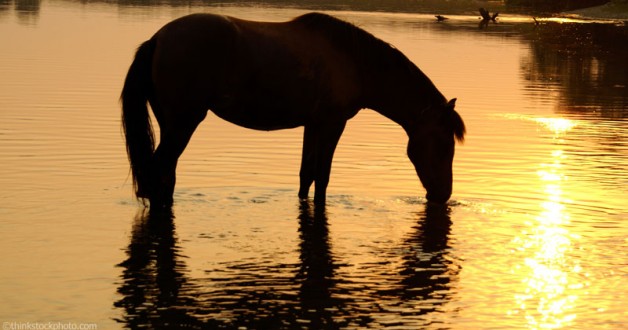By Karen Briggs
Any treatise on caring for horses you’ve ever read probably includes the line, “Provide access to plenty of fresh, clean water.” Though we all understand that this is good advice—after all, all living things need this simple, essential liquid—we don’t tend to give water a lot of consideration as part of the equine diet.
The reality is that water is the most important nutrient, bar none. Without water almost all of your horse’s systems cease to function, as it:
- Aids in thermoregulation (the maintenance of the horse’s body temperature);
- Lubricates the joints;
- Helps cushion the central nervous system;
- Is involved in both sight and hearing;
- Aids in digestion;
- Acts as a solvent for toxins and helps eliminate them through urine and sweat; and
- Helps maintain an elastic skin tone.
To give you another perspective on water’s importance, consider that horses can survive without food for up to three weeks, but they can only survive without water for a maximum of five to six days. Though water intake varies based on the horse’s exertion level, the ambient temperature, the components of his diet, and other factors, the average 1,000-pound horse needs a bare minimum of three to eight gallons a day to function at a maintenance level.
Horses quickly become dehydrated without sufficient water. Within 24 hours of water deprivation, they may lose about 4% of their bodyweight, through a combination of sweating and urination, manure, and respiration. After 48 hours without water, they have lost 6.8% of their bodyweight; after 72 hours, about 9% … and if summer heat is involved, that number may skyrocket to 16%. The symptoms of dehydration—dry mucous membranes, sunken eyes, a tucked-up appearance, skin that has lost its elasticity, and a slowed capillary refill time—only become obvious when the horse already has lost 6% of his bodyweight or more. By that time, dehydration has already wreaked its devastating effect on athletic performance and digestive efficiency. Both functions take a nosedive in the absence of water—and decreased digestive function can quickly lead to colic. In fact, the main reason the incidence of colic increases from December to March is that many horses don’t drink enough water in the winter months (often because their water supply has been allowed to freeze over).
Winter isn’t the only time horses are at risk for colic due to restricted water intake, however. Any time a horse faces a rapid decrease in water consumption, he’ll be more prone to impaction colic, especially if a good part of his diet is dried forage. Horses grazing fresh, juicy pasture can extract much of their water needs from their grass intake, but those eating hay or roughage cubes need to drink significantly more so that their gastrointestinal systems can churn the dried forage into a digestible slurry.
Mares in foal or lactating (or both) have increased needs for water, largely because they are satisfying their increased energy and protein needs by taking in more feed but also because they lose some water in the placental fluids and in producing milk. Although foals satisfy most of their liquid requirements by nursing, most will begin to drink water at the age of only one to two weeks. It’s a habit that begins early and lasts a lifetime.
The other reason horses become dehydrated is excessive water loss through sweating, as can happen in heat and humidity, especially when stressful exercise is involved. When temperatures are high, water needs can increase by three to four times with work. Horses with diarrhea or scours also become dehydrated quite rapidly, and the water loss in this case makes thermoregulation difficult and contributes to fever.
Whatever the reason behind it, dehydration is a situation best prevented. The easiest way to ensure your horse never gets dehydrated is to make sure he always has access to clean, fresh water, regardless of the weather.



